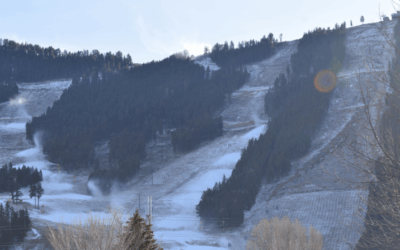Make our newscast part of your daily listening routine. Subscribe on Spotify (or wherever you listen to podcasts).
It’s expected that wear and tear over several decades will eventually prevail over the metal bolts drilled into rock to help catch climbers when they fall.
That’s why checking up on and addressing the anchors when they become loose is a top priority for the Teton Climbers Coalition, a Jackson-based nonprofit.
The coalition’s founder, Christian Beckwith, recently learned that there have been a few “bad bolts” found on routes at Lower Blacktail Butte, a popular climbing area in the southern part of Grand Teton National Park.
The routes with known loose bolts include Inconceivable (5.11a), Do the Right Thing (5.11c/d) and Time Flies When You’re Alive (top access bolts), according to Beckwith and the Jenny Lake Rangers.
“We think those bolts might’ve been loosened because they are ones at cruxes, at the hard parts of the routes, and people may have been simply falling on them for many years. That might have loosened them,” said Beckwith, the nonprofit’s executive director since he founded the organization in March 2020.
The use of climbing bolts is common in many of the country’s national parks, though it has recently found its way to the center of controversy. Some environmentalists argue that the bolts are in opposition to the Wilderness Act’s “Leave No Trace” principles.
The Jenny Lake Rangers instagram page first posted warnings about the loose bolts Monday. That evening, Beckwith was in a board meeting with members of the coalition figuring out next steps.

The Jenny Lake Rangers are Grand Teton National Park’s highly trained search-and-rescue members. Responding to calls in the park are the top priority, but the Rangers can also be found guiding nature walks and issuing backcountry permits. (KHOL/Jenna McMurtry)
“Potentially unsafe glue-in bolts located at the Lower Blacktail Butte wall. On [Monday], Climbing Rangers found multiple bolts on multiple routes to be loose, and wiggling by hand, with the epoxy chipping away,” the post reads.
The Rangers advise that climbers “proceed with extreme caution when climbing at this wall until a more thorough investigation of the issue can be conducted.”
A “climbing modernization” effort has been underway at the coalition for a few years now, Beckwith said. The effort is particularly timely given that many local routes were set upwards of three to four decades ago.
Beckwith added that it’s time for a few more routes to get a reset, something the coalition has already begun work on at the nearby Upper Blacktail Butte.
As to when the coalition will “replace the suspect hardware” at the area’s lower wall, depends on the timeline for stewardship team member Garrick Hart’s return from his current climb up the Grand Teton (Hart’s day job is guiding for Exum).
“Which is to say, this weekend,” Beckwith added in a text message.
Climbers can report other loose or broken bolts they encounter via the coalition’s “bad bolt” form.






